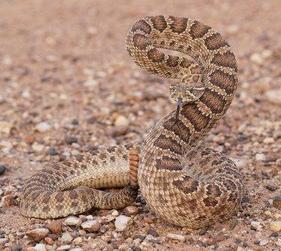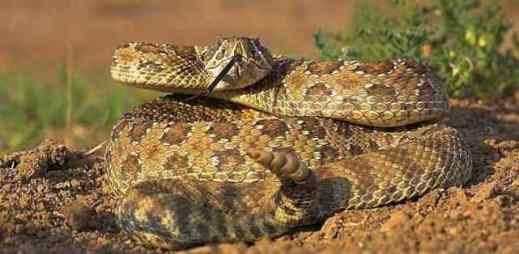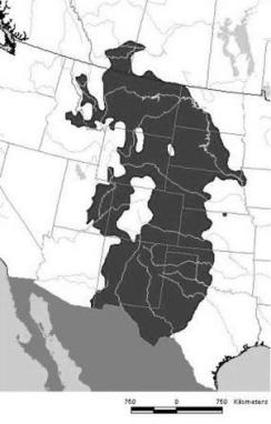Prairie RattlesnakeCrotalus viridis |

Custom Search
|
These rattlesnakes are found in North America over much of the Great Plains in central the United States east of the Rocky Mountains.
Their huge distribution ranges from southwestern Canada through the United States from Montana and Idaho east to western Iowa and south to Texas and into northern Mexico. They inhabit most of Montana, where it is one of 10 snake species but the only venomous one found in the state. In Canada, they occur in southern Alberta and Saskatchewan provinces, and in Mexico are found in northwestern Chihuahua and northern Coahuila. The prairie rattlesnake is the only venomous snake found in the Canadian prairies. They are found mostly in grasslands and prairies but also in woods, forests, brush, caves, rock ledges, and alongside streams. The species tends to avoid desert areas. Prairie rattlesnakes are found from near sea level up to over 9000 ft (2700 m) of altitude in Wyoming. The prairie rattlesnake commonly grows to more than 3 feet (100 cm) in length, with the maximum recorded size reaching almost 5 ft. They reach their maximum size in Montana were individuals sometimes reach 4 ft in length. They vary in color, most specimens are greenish gray, olive green or greenish brown, but some snakes are yellowish or light brown. The back is covered with a series of brown or black blotches which flatten into rings on the tail. Males usually have more rings than female snakes. They have a cream, pale yellow to a white colored underbelly. Like most pit vipers they have a narrow neck and a distinct triangle-shaped head equipped with heat sensing pits, located on each side of the head between the eyes and nostril.
In winter the prairie rattlesnake brumates, they sometimes congregate by the hundreds in the same hibernation den. These snakes often use the same den year after year. The prairie rattler is typically active by day in cooler months and becomes nocturnal during hot weather.
They are sometimes confused with other species like the Bullsnake, but they have a broad, triangular head and a rattle, measuring up to 2 inches long (5 cm) on the end of the tail. These snakes were reportedly used in the famous Hopi snake dance ritual. Taxonomy / Subspecies The species taxonomy history changed dramatically since 2000, previously 7 other subspecies were recognized. These included C. v. abyssus, C. v. cerberus, C. v. caliginis, C. v. helleri, C. v. cerberus, C. v. concolor, C. v. lutosus and C. v. oreganus. But in 2000 analysis of mitochondrial DNA variation across their range identified only 2 main clades, located east and west of the Rocky Mountains. These were then considered actually 2 different species, the prairie rattlesnake and the Northern Pacific rattlesnake (Crotalus oreganus). The conventional subspecies name were maintained and currently, only 2 subspecies are recognized by scientists. Prairie rattlesnake (Crotalus viridis viridis) Hopi rattlesnake (Crotalus viridis nuntius) 
Venom / Bite
The prairie rattlesnake is a medium-sized snake so their venom glands are small and can contain only moderate amounts of venom. When it bites the prairie rattlesnake can inject from 20 to 55% of its venom stock in a single bite. But they will sometimes deliver a dry bite, up to 20% of the time, where no venom is injected. They do produce a potent venom with neurotoxic and hemotoxic properties, which kills the prey and also helps with the digestion by destroying tissue. Some populations of the prairie rattler are thought to possess the infamous "Mojave toxin" like their relative the Mojave rattlesnake (Crotalus scutulatus). So even with their small size, the prairie rattlesnake is capable of delivering a lethal bite to an adult human, although this is rare. Diet / Feeding Due to the prairie rattlesnakes extensive range, they prey on a variety of animals. Usually, they prefer small mammals, like prairie dogs, voles, shrews, ground squirrels, small rabbits, mice or rats and ground nesting birds and sometimes even other snakes. Juvenile and younger snakes will occasionally feed on smaller amphibians and reptiles. They rapidly strike the prey at a distance is 2/3 of its body length, biting it with their retractable hollow fangs and injecting the venom. They then release the prey waiting for the venom to act and then the rattlesnake swallows it whole. Reproduction The prairie rattlesnake is a viviparous species meaning these snakes give birth to live young after internal fertilization.The mating season occur between March and May, and males may sometimes compete for females, but size isn't major a factor in their mating success. Females only breed every 2 or sometimes every 3 years, and give birth from 4 to 25 live snakes in August to September in late summer to early fall. The clutch size is proportional to the size of the female. It's common for female prairie rattlesnakes to give birth at communal dens. The hatchlings are born about 22 to 28 cm long and are as venomous as the adults. The newborn rattlesnakes are born fully equipped with fangs and toxic venom but without rattles. Instead, they have a small button on the end of the tail and will only be able to rattle after they have shed twice. The young snakes are quite capable of fending for themselves immediately, requiring no parental care. Although because of their small size, their survival rate as young is limited, and many do not live through their first year. Their predators include mammalian carnivores, birds like hawks, eagles or short-eared owls and king snakes. The prairie rattlesnakes reach sexual maturity after 3 years. Conservation / Threats The prairie rattlesnake is classified as Least Concern species on the IUCN Red List. They have a wide range and presumed large population with a stable trend when last assessed in the year 2006. However, like many other rattlesnake species some Local populations have depleted or even eliminated because of killing at dens and habitat degradation or loss for agricultural, residential or commercial development.
|
Did You Know?
The black mamba is considered the world’s fastest snake and moves at speeds up to 20 km/h. Scientific classification |
© 2014 Snake Facts About Us | Privacy Policy | Contact







